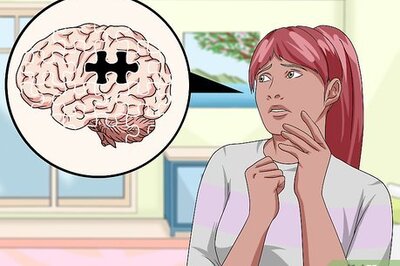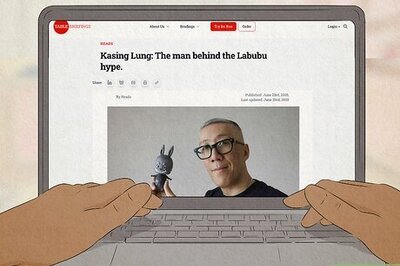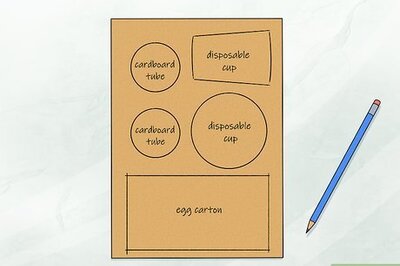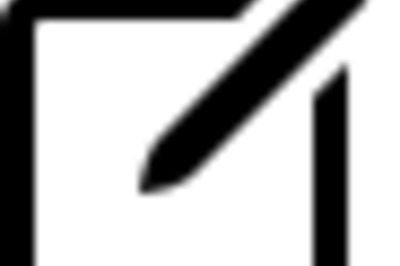
views
What is a pump?
A “pump” is a temporary swelling of your muscles after a workout. When you lift weights or perform workouts that target your muscles, blood rushes into those muscles. At the same time, your veins, which carry blood away, contract, while arteries keep delivering blood. The blood then seeps into the surrounding tissue, causing it to swell, and making your muscles appear bigger and stronger. “Pumping” is when weightlifters or bodybuilders swell their muscles on purpose, to achieve the appearance of larger muscles, or to feel satisfied after a workout. It’s most common after high-intensity, high-rep workouts, where you’re pushing your muscles to their limit. Pumps often last between 2-3 hours, before the blood is reabsorbed and the swelling goes down.
Getting the Best Pump
Perform 3-4 sets of 10-15 reps of your target exercise. Pumps only really work with weightlifting or resistance training—strength training, not cardio. When you pump, focus on 1 target area, like your biceps or chest, and do the same workout 3-4 times, while pushing yourself to finish a high number of reps, up to 15. This strain often results in a nice pump. For example, if you want to pump your biceps, do dumbbell curls. If you want to pump your chest, do bench presses.
Use a moderate amount of weight or resistance. When pumping, you don’t want to go with the heaviest weight or highest resistance, or you’ll burn out before you get your pump. Instead, go with a moderate amount of weight, or a little more, to ensure you can actually finish the reps and get a good amount of blood flow into your muscles. Never overdo it! Stop if you feel lightheaded, exhausted, or in pain. The key to pumping is simply pushing yourself. If you push your limit, you’ll most likely get that pump. No need to go overboard and risk injury.
Take short rests in between each set, and move slowly. The name of the game here is sustained intensity over a longer period of time than your usual workout, to let the most blood flow into your muscles. To achieve this, only rest for 45-90 seconds between sets. And, when you’re doing your reps, take it low and slow.
Eat carbs and stay hydrated before the workout. Your diet and hydration are key factors in maximising your pump. The day before, eat about 50-60 grams of carbs, and sip water all day. The day of, drink about 24-32 ounces of water. This maximises the fluid in your system, ensuring you’ve got plenty of liquids to pump into your muscles. Carb-rich foods include bread, pasta, cereal, rice, and crackers. Supplements, like preworkout mixes with L-arginine or citrulline malate, can help with blood flow and increase your pump, but talk to a dietician to see if these are right for you.
Does pumping build muscle?
Pumps can build muscle, but aren’t the most effective method. There’s research that suggests that pumping increases the synthesis of muscle proteins, while also preventing their breakdown, but this research is also incomplete. Pumping certainly works muscles, but it may not be the most efficient way to build them. What we know for sure is that the risks of overexerting yourself by pumping constantly far outweigh any benefits pumping might bring. Proper muscle building involves muscle hypertrophy, which is the growing of muscle cells, while pumping is more focused on hyperaemia, or the concentration of blood in a muscle. These days, it’s more commonly accepted that training toward muscle failure, like pushing your weight or resistant limits, rather than training toward blood flow, more effectively tears and rebuilds muscles. That’s why frequent pump-focused training isn’t a good idea, and it’s better to focus on more sustainable forms of muscle growth, like regular, varied exercises of increasing intensity.
Should you pump?
Feel free to pump on occasion, but don’t make it your whole workout. Pumps do effectively target certain muscle groups, can increase your stamina and overall strength, and just feel plain good. There’s no harm in going for the pump once a week or so, but you shouldn’t be doing it all the time. You won’t gain muscle as efficiently as when you’re pushing your weight limits, and you risk overexerting yourself. It’s totally fine to pump now and then to get that sick gains selfie, or just to encourage yourself to workout by really feeling your muscle. The key is not relying on it, or letting it fool you into thinking you're making big gains, when really you’re just temporarily swelling your muscles.
Building Muscle Effectively
Stretch and do cardio before you do strength training. Going right into lifting weights when you hit the gym can lead to injury. Instead, warm up with a 5-10 minute stretch routine, and then 5-10 minutes of cardio, such as running or biking. This warms up your muscles and gets them working before you really push them, which can contribute to gains while reducing the risk of injury.
Cycle through your muscle groups, and intensity, each week. It’s not enough to just use pump training every day. You need a balanced workout plan to give your muscles days off, and you also need to introduce cardio to burn fat. Dedicate 1-2 days a week to each muscle group, giving each a few days off. Also, take complete rest days, where you don’t work out or only do light exercise, to give your whole body a break. For example, you might do strength training on Monday and Thursday, with cardio on Tuesday, Wednesday, and Friday. You might implement pump workouts on one day of your strength training, then do higher-volume weight lifting on the other. Avoid pure pump training, which doesn’t push the weight limits of your muscles.
Focus on explosive lifts with heavier weights. Research shows that explosive movements, where you move quickly on the first part of the rep and slowly on the way back down, more effectively help with muscle building. Rather than going low and slow, like with pump training, aim for explosive movements that push your weight limits. Never lock your joints, like your elbows or knees. Always keep them slightly bent to avoid injury while doing strenuous exercises.
Eat about 56 grams of protein each day. Your diet is a vital part of gaining muscle, and without proper nutrition, you won’t see those big gains. Adults should eat get at least 10-30% of their daily calories from protein—that works out to about 56 g for most adults. And don’t just get it all in one meal! Space it out throughout the day so your body has easy access to it at all times, during your workout and after. Protein-rich foods include chicken, fish, beef, yogurt, tofu, milk, and beans.
Get 7-8 hours of sleep each night. “Muscle growth occurs during sleep,” says certified personal trainer Alphonso White. That’s why it’s important to get a good night’s sleep the night after a big workout, so that while resting, your body can get to work repairing your torn muscles and making them bigger and stronger.
Final Takeaways
Pumps are great for making muscles look and feel bigger temporarily. That’s because when you pump, blood is flowing into those muscles faster than it can flow out of it. The effect is only temporary, though, and while pumps certainly work muscles and strengthen your body, like any workout, experts are split on if they’re actually a good way to build muscle. Instead, they recommend gradually increasing your weight and resistance limits. To pump, do one weight or resistance-oriented exercise for 3-4 sets of 10-15 reps at a time. Use a moderate weight, not your max weight, take it slow, and only rest for 60-90 seconds between sets.




















Comments
0 comment